Introduction to the Pinto Horse
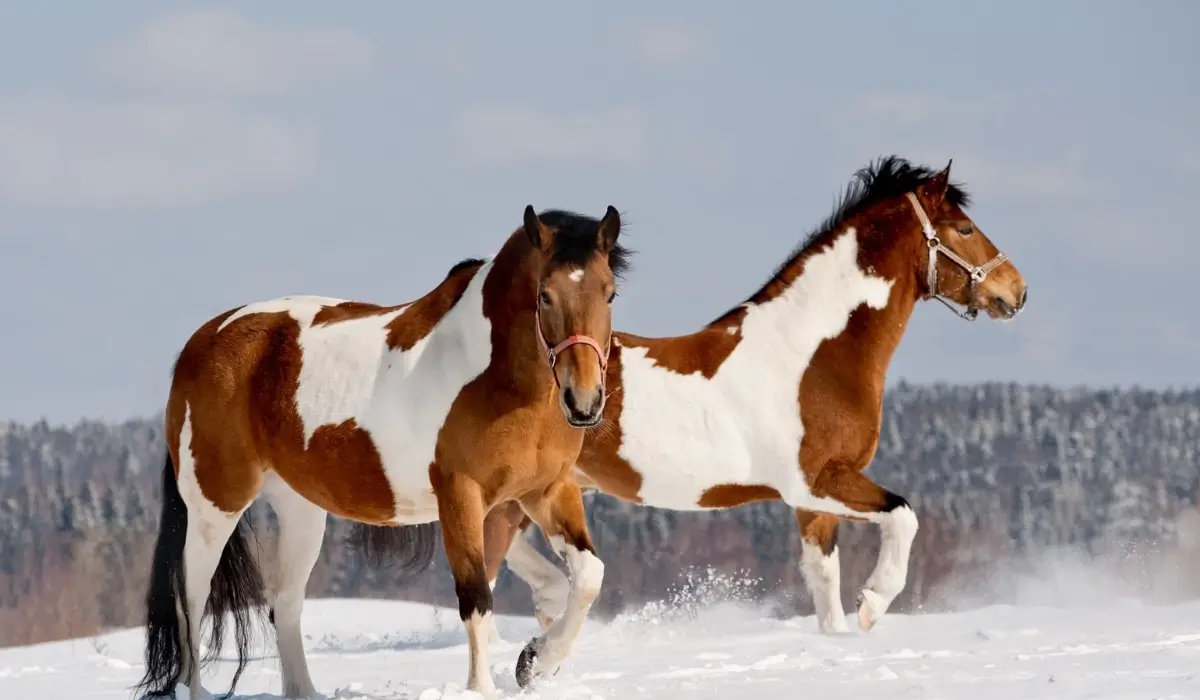
Unmistakable in their splendor, Pinto horses gallop through the equestrian world with a distinct flair that captivates onlookers and horse enthusiasts alike. This equine variety is celebrated not just for its performance but also for its unique coat that exhibits a kaleidoscope of colors. In this exploration, we delve into the essence of what makes Pinto horses an enduring symbol of equine beauty and diversity.
Pinto Horse Characteristics
The Pinto horse is renowned for its striking coat pattern featuring large patches of white intermingled with another color. These patterns are as varied as the horses themselves, with no two Pintos wearing the exact same coat. Beyond their distinctive markings, these horses display a wide range of physical attributes since the term “Pinto” refers to a color pattern rather than a specific breed.
How to Identify a Pinto Horse
Recognizing a Pinto horse involves looking for the characteristic color patterns that define this group. A Pinto will typically have a coat showcasing bold, irregular patches of white and another color, often black, brown, or chestnut. The patterns can manifest in several distinct ways, which we will explore later on, contributing to the horse’s remarkable appearance.
Exploring the Ancestry of Pinto Horses
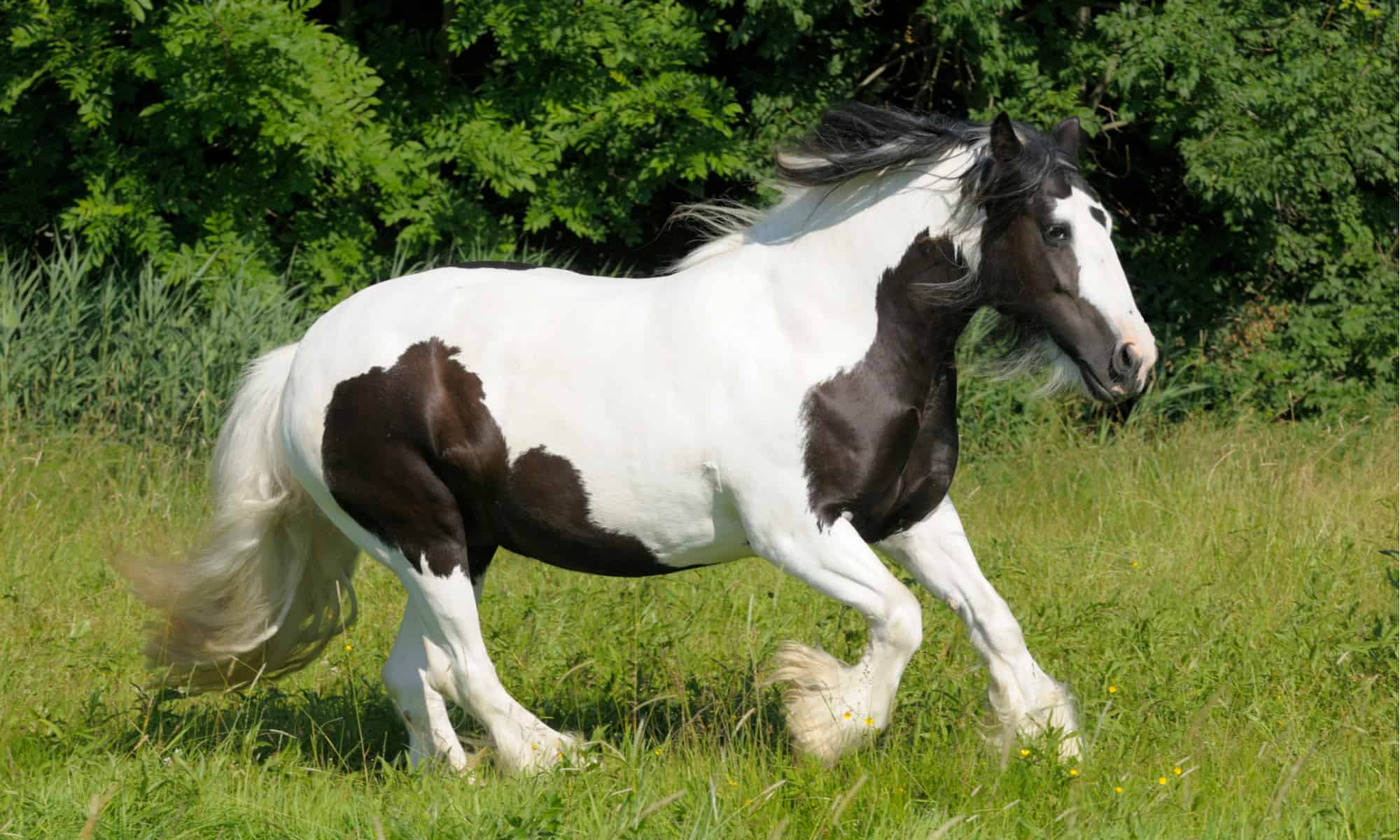
The Pinto horse’s lineage is a narrative as diverse as their coat patterns. These horses have not only been a part of human history; they have also played a significant role in shaping it. Tracing back to the dappled horses of Europe and Asia, these equines were introduced to the Americas by Spanish explorers. There, they interbred with the wild mustangs, and the resulting offspring became synonymous with the spirit of the American West. Throughout the ages, civilizations have held the Pinto in high regard for their distinct appearance, which served as both a practical asset and a symbol of great importance.
Unraveling the Mysteries of Pinto Coat Patterns
The breathtaking coat patterns of Pinto horses are the result of a complex genetic matrix. While their beauty is evident at first glance, the genetic intricacies that create their coat variations are a testament to nature’s diversity. The interplay of dominant and recessive genes determines the presence and intensity of Pinto patterns, which are not confined to any single horse breed, allowing for a wide array of equines to exhibit these distinctive markings.
Distinguishing Features of Pinto Markings
- The Role of the KIT Gene: This gene is crucial in creating the Tobiano pattern, influencing how white and pigmented cells are arranged on the horse’s coat.
- Understanding Frame Overo: This gene is responsible for the distinctive Overo pattern, dictating the shape and positioning of the white patches.
- The Influence of SB1 Gene: Associated with the Sabino pattern, this gene can cause a range of white spotting, from subtle to extensive.
Global Significance of Pintos
Cultures around the world have cherished Pinto horses, often attributing special meanings to them. In European history, these horses were celebrated in art and folklore, indicating a long-standing admiration. Native Americans esteemed Pintos for their striking beauty and spiritual importance, frequently selecting them as the mounts of choice for tribal chiefs and warriors. The Pinto’s versatility and robust nature have allowed it to thrive in various climates and conditions, thereby enhancing its global appeal and playing a role in the emergence of horse breeds known for Pinto coat patterns.
Understanding Pintos’ Cultural Resonance
- Renaissance artworks often featured Pintos as emblems of wealth and prestige, accompanying figures of high social standing.
- Pintos occupy a prominent place in Native American lore, celebrated for their keen intelligence and spirited nature.
- In the era of the American cowboy, Pintos were valued as loyal partners, and their unique looks became synonymous with frontier life.
Conservation of Pinto Horse Bloodlines
The dedication to preserving Pinto horse bloodlines has led to the formation of specialized registries and associations. These groups are committed to upholding the integrity of the Pinto’s distinctive coat patterns and ensuring the breed’s future through conscientious breeding. Documenting pedigrees and monitoring genetic markers are crucial to maintaining the breed’s narrative, which is an ongoing part of both its historical and current equestrian significance.
The Importance of Registries for Pinto Preservation
| Registry | Contribution |
|---|---|
| Pinto Horse Association of America | Ensuring the integrity of color patterns and overall conformation |
| International Patterned Horse Registry | Global documentation and recognition of Pinto horses |
With an understanding of their profound ancestry and the genetic wonders that dictate their coat patterns, Pinto horse aficionados can gain a deeper appreciation for these equine marvels. The rich tapestry of their history, interwoven with cultural narratives and biological intricacies, cements the Pinto’s status as a breed of historical and aesthetic significance.
Understanding Pinto Horse Color Variations
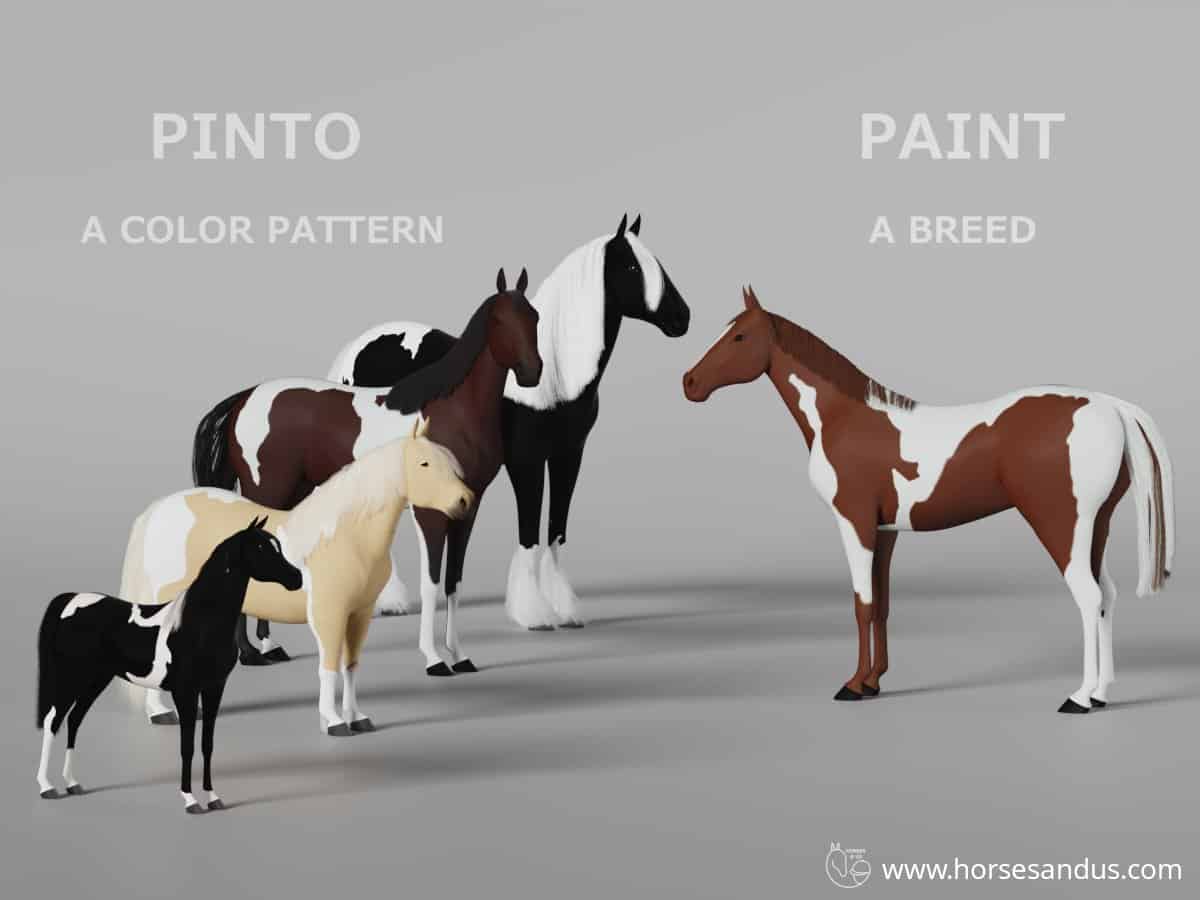
The vibrant spectrum of Pinto horse colors and the genetic legacy behind it are fascinating topics for equine enthusiasts. Pintos are known for their diverse and unique coat patterns, each portraying its own genetic story. The vast array of color combinations offers insights into the rich genetic background of these beautiful horses, with each Pinto presenting a distinct canvas of base color and white markings.
Base Colors and Markings of Pintos
Pinto horses exhibit a wide range of base colors that accentuate their white patterns. These colors can range from the more common black, bay, chestnut, and buckskin to the less frequent palomino, gray, and blue roan. The interplay of these colors with the white patches results in a myriad of stunning visual effects, which are unique to each individual horse.
Unique Pinto Markings and Their Genetics
The Pinto horse is celebrated for its array of pattern types, each with distinct traits that contribute to the horse’s identity. The genetics behind these patterns are intricate, and ongoing research continues to decode the specific alleles responsible for the variation in Pinto coat appearances. Breeders benefit from genetic testing which can predict the potential for certain patterns to be passed down to progeny, ensuring the continuation of these enchanting traits.
- Tobiano: This pattern type is marked by rounded patches and often includes a white mane and tail.
- Overo: Overo Pintos display asymmetrical and splash-like markings, which stand out against their base color.
- Tovero: Exhibiting characteristics of both Tobiano and Overo, Toveros may have distinct facial markings like the “medicine hat.”
- Sabino: Sabino Pintos feature delicate, lace-like white markings that often include a bold, white face.
- Splashed White: These Pintos have a solid white underside and can have blue eyes, resulting from specific genetic influences.
- Brindle: Though rare, Brindle Pintos have a streaky appearance with alternating dark and light stripes.
Pinto horse patterns serve as more than merely aesthetic features; they represent a complex genetic history. With each pattern variation, we uncover more about the horse’s ancestry and the genetics shaping their coats. As we unveil these secrets, our fascination and reverence for the Pinto horse continue to grow.
The Genetic Mosaic of Pinto Patterns
Delving further into the genetic underpinnings, it’s clear that Pinto patterns are the product of diverse genetic interactions. The study of equine genetics has illuminated the specific genes responsible for these patterns, improving our understanding of inheritance and expression in Pintos. Such knowledge empowers breeders to make informed decisions in their breeding programs, aiming to preserve and enhance these captivating coat patterns for future generations.
The Story Behind the Patterns
The distinctive coat patterns of Pinto horses have captivated humans throughout history, inspiring countless cultural and artistic representations. These patterns have not only adorned ancient art but have also become iconic in contemporary equine events. Their historical and cultural presence underscores the profound bond between humans and these majestic creatures, and their striking patterns continue to be a source of admiration and inspiration around the world.
As we gain more insight into the complexities of pinto horse patterns, our appreciation for the beauty and genetic diversity of these animals deepens. The story that unfolds from their coats — a blend of pinto horse colors and types of pinto horses — reflects a rich tapestry of equine heritage and human fascination.
Distinctive Pinto Patterns Across Diverse Breeds
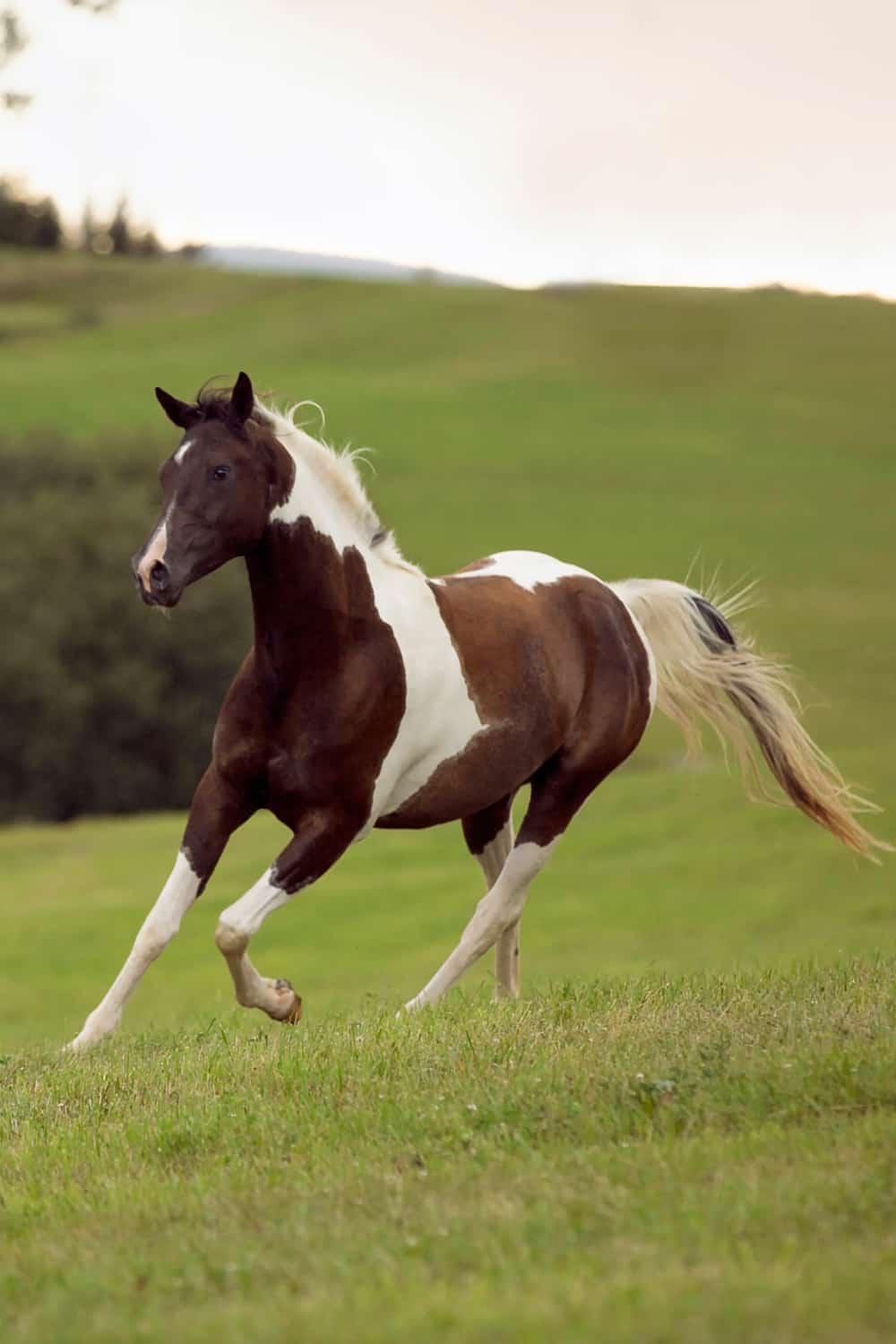
Various horse breeds showcase the vibrant and diverse Pinto patterns, each contributing its unique history and physical traits to the Pinto’s mesmerizing appeal. From the agile Arabian to the robust American Paint Horse, these patterns bestow a unique beauty on each breed. The Pinto’s visual impact is not limited to a single type of horse; it graces an array of breeds, each with its own distinct characteristics and charm. Let’s delve into the breeds that carry this colorful legacy.
Breeds that Flaunt Pinto Patterns
- American Paint Horse: This breed is often associated with the Pinto pattern and is prized for its strength, good temperament, and suitability for western sports.
- Mustang: The feral Mustangs, sometimes adorned with Pinto coats, embody the spirit of the American wilderness and their resilience.
- Arabian: Arabians with Pinto markings combine the breed’s inherent grace with the visual splendor of Pinto patterns.
- Miniature Horse: These diminutive equines with Pinto coloring captivate with their balanced proportions and dynamic patterns.
Exotic Breeds and Pinto Splendor
While some breeds are renowned for their Pinto patterns, there are also exotic and less common equines that exhibit these striking colors. Examples include:
- Gypsy Vanner: With roots in the British Isles, Gypsy Vanners often have Pinto patterns along with their distinctive feathered legs.
- Shetland Pony: The Shetland Pony, though compact, can sport the Pinto’s vivid colors, enhancing their appeal to a wide audience.
- Drum Horse: Drum Horses, known for their significant size and weight, can display bold Pinto patterns that complement their majestic stature.
How Pinto Patterns Accentuate Breed Characteristics
The unique attributes of each breed are often highlighted by the Pinto patterns they carry. For instance, the sleekness of an Arabian’s coat contrasts with the Pinto markings, emphasizing the breed’s elegance. In contrast, the Miniature Horse’s small frame can be dramatically adorned with Pinto patterns, showcasing a delightful visual contrast.
Genetic Diversity and Pinto Expression
The manifestation of Pinto patterns varies among breeds, offering a fascinating array of appearances. This variation is due to genetic factors that influence how these patterns are expressed, adding to the allure and complexity of each breed’s genetic makeup.
Influence on Breed Recognition
The Pinto patterns can significantly enhance a breed’s popularity by attracting attention to its visual appeal. When these striking patterns are combined with a breed’s inherent qualities, they create a desirable combination for those seeking both aesthetic beauty and practical traits in their horses.
Strategic Breeding for Pinto Preservation
Intentional breeding efforts are essential to foster the Pinto pattern within various breeds. Breeders take into account genetic influences to encourage the appearance of these patterns in offspring while maintaining the breed’s fundamental characteristics.
The Pinto pattern’s beauty is magnified by the diverse equine breeds it adorns, each amplifying the Pinto’s dramatic coloring. The Pinto horse breeds continue to enchant enthusiasts with their distinctiveness and the remarkable genetic stories they tell.
Ensuring the Well-being of Your Pinto Horse

Providing the right care for Pinto horses involves a holistic approach that encompasses their dietary, dermatological, and physical needs. The unique coat patterns of these horses not only contribute to their stunning appearance but also require particular attention to maintain their health and luster.
Feeding for Optimal Health
A balanced diet is crucial for Pintos to support their energy levels and vibrant coats. Their nutritional plan should include:
- A base of premium forage to satisfy their core dietary needs.
- Energy-rich feeds for those with higher activity demands.
- Essential vitamins and minerals to fill any dietary deficiencies.
Owners should be vigilant about their Pintos’ feeding schedule to prevent weight-related health issues.
Maintaining Physical Fitness
Keeping Pinto horses physically active is important for their overall health. A well-rounded exercise regimen can consist of:
- Ample turnout time in a secure environment.
- Customized training schedules for competitive horses.
- Relaxed rides to engage their mental acuity.
Always adjust the exercise to suit the horse’s specific needs and capabilities.
Skin and Coat Maintenance
Consistent grooming is crucial for Pinto horses, serving to enhance the horse-human relationship and ensuring the skin remains healthy. Their grooming routine should include:
- Regular brushing to keep the coat clean and distribute natural oils.
- Use of horse-specific shampoos to avoid dermal irritation.
- Extra attention to the white areas of their coat to prevent stains.
Regular skin checks, particularly under the white patches, are important to detect any issues early on.
Elemental Protection Strategies
Pinto horses’ distinctive white patches can be more susceptible to the elements, necessitating specific protective measures, such as:
- Applying sunblock made for equine use to shield against UV rays.
- Utilizing protective clothing to ward off insects and harsh weather.
- Ensuring access to adequate shelter in all weather extremes.
These protective steps are crucial in maintaining the Pinto’s skin integrity and comfort.
Proactive Healthcare Practices
Preemptive healthcare is a cornerstone in maintaining any equine’s well-being. To keep Pinto horses healthy, essential practices include:
- Staying current with immunizations to ward off infectious diseases.
- Administering antiparasitic treatments to avoid infestations.
- Conducting regular dental examinations for optimal nutrition and health.
Annual veterinary evaluations are recommended to proactively manage health concerns.
Special Health Considerations
While Pinto horses are generally sturdy, they can be predisposed to specific health issues, particularly those affecting their skin. To manage these concerns effectively:
- Monitor the horse for any signs of discomfort or unusual behavior.
- Seek veterinary advice if you notice any abnormalities in the skin.
- Act swiftly on treatment recommendations to curb the progression of any condition.
Vigilance in health matters enables prompt intervention when needed.
Hoof Care Imperatives
Hoof maintenance is a critical aspect of care for Pinto horses. To ensure their hooves are in top condition:
- Arrange for routine farrier services to trim and balance hooves.
- Apply hoof conditioners as necessary to preserve hoof integrity.
- Address any signs of hoof discomfort or disease without delay.
Healthy hooves are a foundation for Pinto horses’ mobility and overall well-being.
By embracing these comprehensive care principles, owners and caretakers can provide Pinto horses with the support they need to thrive. An integrated approach to nutrition, conscientious grooming, and holistic healthcare will enable these stunning equines to display their remarkable coat patterns with pride and vitality.
Clarifying the Distinction: Pinto Versus Paint Horse
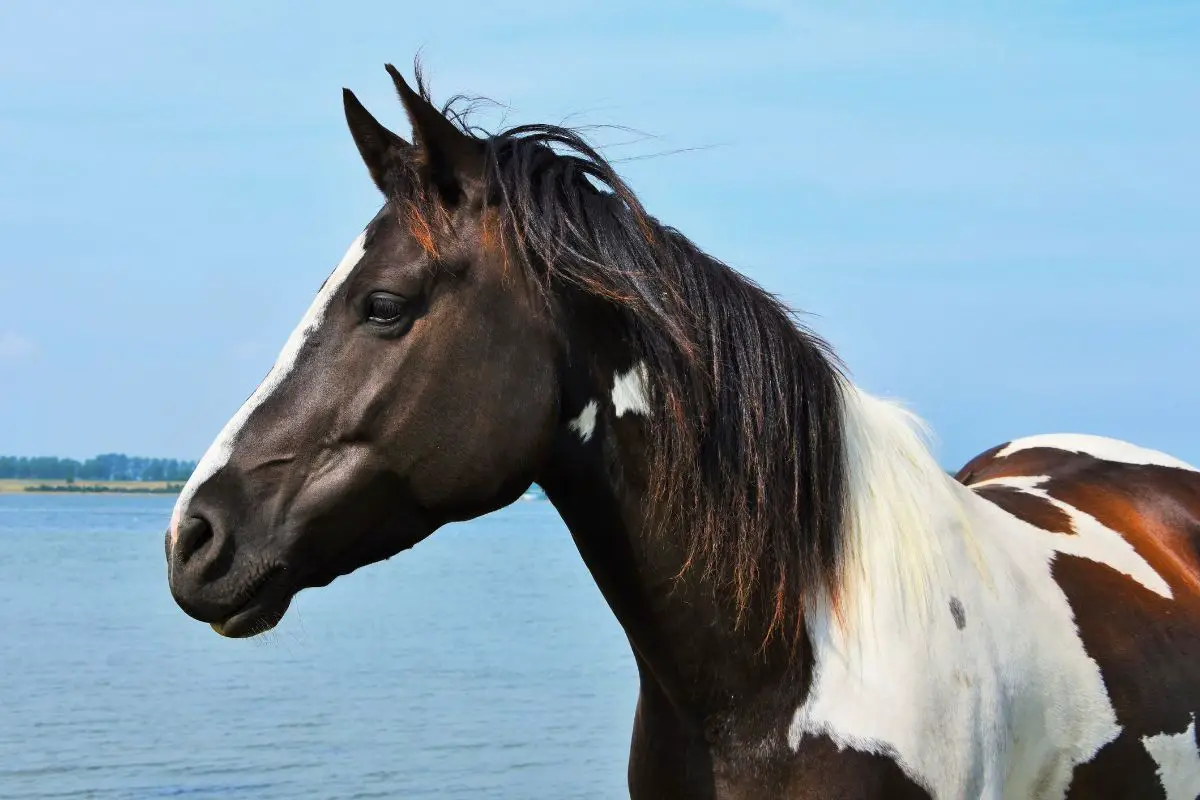
The Pinto and the American Paint Horse often cause confusion due to their similar coat patterns. However, a Pinto encompasses a variety of breeds with a particular coloration, not a breed itself, whereas the American Paint Horse is a recognized breed with Quarter Horse and Thoroughbred heritage. The latter must meet the American Paint Horse Association’s pedigree requirements for registration.
Understanding Registration and Breed Criteria
Understanding the registration criteria highlights key differences between these two types of horses. The American Paint Horse Association mandates that Paint Horses have ancestry that includes Quarter Horse or Thoroughbred lineage, in addition to specific conformation standards. Pinto registries, such as the Pinto Horse Association of America, focus predominantly on the horse’s coat pattern for eligibility, without stringent lineage prerequisites.
Exploring Coloration and Breed Versatility
While both Paints and Pintos have coats with white and colored patches, there are variances in their breed diversity. Paint Horses typically display one of the recognized Pinto patterns — Tobiano, Overo, or Tovero — yet their breed is not defined by these patterns alone. Pintos, in contrast, may belong to various breeds, all showcasing the characteristic Pinto coloration, irrespective of the breed standard colors.
Genetic Considerations in Breeding
For breeders, the genetic makeup behind these horses’ coats is critical. Paint Horses are subject to the breeding regulations of the APHA to maintain their breed standards, while Pintos can be crossbred among different breeds to achieve the desired coloration. This breeding approach allows for genetic diversity among Pintos but also necessitates deliberate planning to preserve the distinctive coat patterns.
Delineating Performance and Functionality
Paint Horses are often bred for particular performance traits, excelling in various Western disciplines due to their Quarter Horse heritage. Pintos, celebrated for their aesthetic appeal, are versatile and participate in a wide range of equestrian disciplines and recreational riding, reflecting their adaptability.
The Cultural Significance of Pinto and Paint Horses
Both horse types have significantly influenced equine culture. The APHA champions the heritage and capabilities of the American Paint Horse, while Pinto organizations honor the pattern’s widespread occurrence among different breeds. Their unique histories contribute to their distinct recognition within the equestrian community.
Essential Distinctions
- The American Paint Horse is a specific breed with strict registration standards, contrasting with the Pinto, which is identified by a color pattern across diverse breeds.
- Paint Horses require verifiable breed heritage, whereas Pintos are classified by their distinctive coat coloration.
- Paint Horses are often associated with Western riding sports, while Pintos exhibit versatility across a spectrum of equestrian activities.
- Dedicated registries and associations exist for both Pintos and Paint Horses, each working to preserve their distinct identities and promote their historical and cultural value.
Awareness of the nuances between Pinto horses and American Paint Horses is valuable within the equestrian landscape. Though their coats may be similar, understanding their breed standards, registration processes, genetic backgrounds, and intended uses allows for a greater appreciation of their individual characteristics.
Delving Deeper into Pinto Horse Enquiries
The allure of the Pinto horse, with its eye-catching coat and versatile nature, often leads enthusiasts to seek more information. This section aims to enhance knowledge about these distinctive horses by addressing questions commonly posed by those intrigued by the Pinto’s unique qualities.
-
Understanding the Piebald Term
‘Piebald’ is a term specifically denoting horses with black and white coats, whereas ‘Pinto’ refers to horses with white patches alongside various other colors, such as bay, chestnut, or palomino, thus encompassing a broader array of color patterns.
-
Prospects of Breeding Pinto Horses
While breeding two Pinto horses may enhance the likelihood of a Pinto-patterned foal, genetic variability means it’s not guaranteed. The interplay of different genes can produce an assortment of coat patterns, making each breeding somewhat unpredictable.
-
Suitability of Pinto Horses for Novices
Pinto horses can be a great match for beginner riders, provided the individual horse exhibits a temperament and level of training appropriate for the rider’s experience. A well-mannered Pinto can offer a welcoming introduction to riding.
-
Pinto Horse Health Considerations
Though typically strong and resilient, Pinto horses may face a higher risk of certain skin conditions due to their white markings. Proactive care, including the application of sunblock and ongoing health monitoring, can help manage these risks.
-
Grooming Needs of Pinto Horses
Owners of Pinto horses should embrace a diligent grooming routine to keep their coats, particularly the white areas, clean and vibrant. This includes regular brushing and the use of appropriate cleaning products.
-
Competitive Versatility of Pinto Horses
Pinto horses are not confined to Western disciplines; they have also demonstrated their abilities in dressage, show jumping, and other English riding sports, proving their adaptability and athleticism.
-
The Expected Longevity of Pinto Horses
Pinto horses generally share the same lifespan as other horse breeds, averaging between 25 to 30 years. This can vary based on care, nutrition, and overall lifestyle.
-
Climate Adaptability of Pinto Horses
While Pintos can adapt to different environments, their coat and skin may require additional care in extreme climates, such as protection from UV rays in sunny locales or measures to maintain coat health in colder regions.
Exploring these frequently asked questions sheds light on the unique aspects of caring for and understanding Pinto horses, deepening the connection between these distinctive equines and their admirers.
If you’re passionate about horses and looking to expand your knowledge on different breeds, you’ve come to the right place. While you may be curious about the unique patterns of a Pinto horse, why not also explore other breeds? Learn about the beautiful shades of a dun horse, the historical significance and characteristics of a Morgan horse, or the versatility of a POA (Pony of the Americas) horse. Each breed has its own distinct traits that make them special to equestrians and horse enthusiasts alike.
Conclusion
The Pinto horse dazzles with its stunning patterns, rich heritage, and the genetic marvel that paints its coat. Whether standing in a sunlit paddock or galloping freely across open fields, the Pinto continues to enchant and inspire. These horses are not just a feast for the eyes but also a testament to the diversity and beauty of the equine world.



